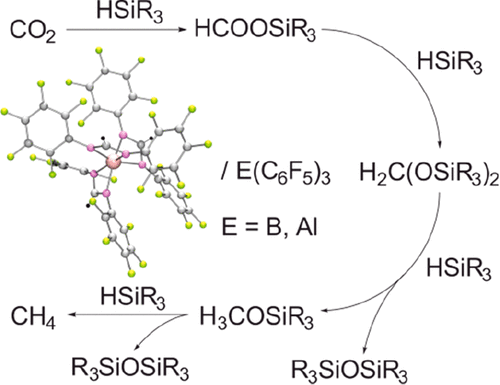当前位置:
X-MOL 学术
›
Organometallics
›
论文详情
Our official English website, www.x-mol.net, welcomes your
feedback! (Note: you will need to create a separate account there.)
Reduction of CO2 by Hydrosilanes in the Presence of Formamidinates of Group 13 and 12 Elements
Organometallics ( IF 2.5 ) Pub Date : 2020-02-24 , DOI: 10.1021/acs.organomet.9b00853 Weiheng Huang 1 , Thierry Roisnel 2 , Vincent Dorcet 2 , Clement Orione 3 , Evgueni Kirillov 1
Organometallics ( IF 2.5 ) Pub Date : 2020-02-24 , DOI: 10.1021/acs.organomet.9b00853 Weiheng Huang 1 , Thierry Roisnel 2 , Vincent Dorcet 2 , Clement Orione 3 , Evgueni Kirillov 1
Affiliation

|
Homoleptic complexes 1-M of group 13 and 12 elements (M = B–In and M = Zn, respectively) incorporating electron-withdrawing formamidinate ligands {(C6F5)N═CHN(C6F5)}− ({NCN}−) were synthesized and isolated in high yields. The compounds were characterized by X-ray crystallography, NMR spectroscopy, and elemental analysis. While the single-component 1-M appeared to be sluggishly active or inactive in the reduction of CO2 with hydrosilanes, a good catalytic performance was achieved with the two-component systems derived from combinations of 1-M and E(C6F5)3 (E = B, Al). In particular, the binary combination 1-Al/B(C6F5)3 showed the best performance within the whole series, thus providing quantitative hydrosilane (Et3SiH) conversions under a range of conditions (PCO2, temperature, benzene or bromobenzene solvent) and affording mainly CH2(OSiEt3)2 and CH4 as products. Kinetic and mechanistic studies revealed that at the initiation step the binary catalytic systems undergo a complex transformation in the presence of CO2/Et3SiH, affording the products of 1-Al decomposition: namely, (C6F5)N(H)SiEt3, (C6F5)N(Me)SiEt3, {NCN}SiEt3, and also some unidentified aluminum species. Thus, the overall process of the reduction of CO2 with hydrosilanes is presumed to be catalyzed by complex multisite systems, evolved from the formamidinate precursor 1-Al, implicating different tandem combinations of N-base/B(C6F5)3 with putative Al-containing species.
中文翻译:

在第13和12组元素的甲酰胺存在下通过氢硅烷还原CO 2
均配型络合物1-M组13和12层的元件(M = B-In和M =锌,分别地)结合的吸电子配体甲脒盐{(C 6 ˚F 5)N═CHN(C 6 ˚F 5)} -({合成并以高收率分离出NCN} -)。通过X射线晶体学,NMR光谱和元素分析来表征化合物。虽然单组分1-M在用氢硅烷还原CO 2时似乎反应迟钝或不活泼,但衍生自1-M和E(C 6 F5)3(E = B,Al)。特别是,二元组合1-Al / B(C 6 F 5)3在整个系列中表现出最好的性能,因此在一定条件下(P CO 2,温度,苯)可提供定量的氢化硅烷(Et 3 SiH)转化率或溴苯溶剂),并主要提供CH 2(OSiEt 3)2和CH 4作为产物。动力学和机理研究表明,在引发步骤中,二元催化体系在存在CO 2 / Et 3的情况下经历复杂的转化SiH,产生1-Al分解产物:(C 6 F 5)N(H)SiEt 3,(C 6 F 5)N(Me)SiEt 3,{NCN} SiEt 3以及一些未识别的铝种类。因此,推测用氢硅烷还原CO 2的整个过程是由复杂的多部位系统催化的,该系统是从甲酰胺基前体1-Al演变而来的,涉及N-基/ B(C 6 F 5)3与推定的含铝物质。
更新日期:2020-02-25
中文翻译:

在第13和12组元素的甲酰胺存在下通过氢硅烷还原CO 2
均配型络合物1-M组13和12层的元件(M = B-In和M =锌,分别地)结合的吸电子配体甲脒盐{(C 6 ˚F 5)N═CHN(C 6 ˚F 5)} -({合成并以高收率分离出NCN} -)。通过X射线晶体学,NMR光谱和元素分析来表征化合物。虽然单组分1-M在用氢硅烷还原CO 2时似乎反应迟钝或不活泼,但衍生自1-M和E(C 6 F5)3(E = B,Al)。特别是,二元组合1-Al / B(C 6 F 5)3在整个系列中表现出最好的性能,因此在一定条件下(P CO 2,温度,苯)可提供定量的氢化硅烷(Et 3 SiH)转化率或溴苯溶剂),并主要提供CH 2(OSiEt 3)2和CH 4作为产物。动力学和机理研究表明,在引发步骤中,二元催化体系在存在CO 2 / Et 3的情况下经历复杂的转化SiH,产生1-Al分解产物:(C 6 F 5)N(H)SiEt 3,(C 6 F 5)N(Me)SiEt 3,{NCN} SiEt 3以及一些未识别的铝种类。因此,推测用氢硅烷还原CO 2的整个过程是由复杂的多部位系统催化的,该系统是从甲酰胺基前体1-Al演变而来的,涉及N-基/ B(C 6 F 5)3与推定的含铝物质。











































 京公网安备 11010802027423号
京公网安备 11010802027423号